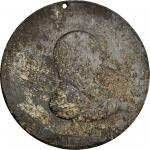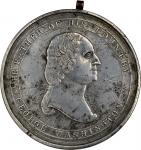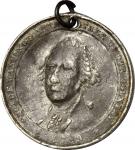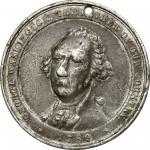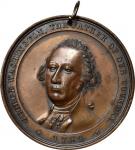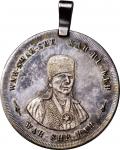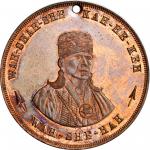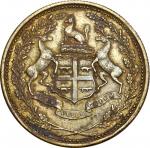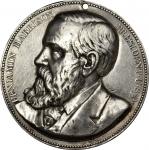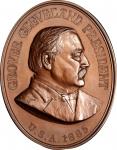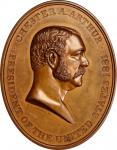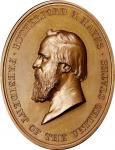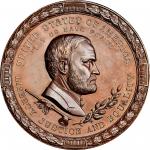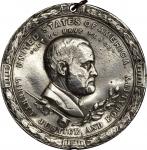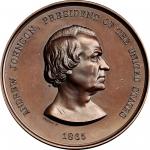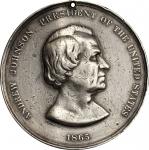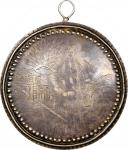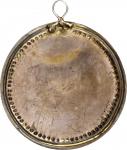19th-Century Engraved Silver Pendant made from one half of a Jefferson Peace Medal. Choice Extremely Fine. 79.3 mm. 395.1 grains. Thin wire suspension loop soldered at 12:00, as made. Mottled light gray and deep bluish gray over most of the obverse while the reverse is a bit more uniform soft golden gray. The edge is crimped, with a raised plain outer border and a prominent repoussé beaded inner border. Minor dents and obvious light wear within the top of the suspension loop indicate that this piece was lovingly worn.This was made from one half of a second-size Thomas Jefferson Indian Peace medal shell (Julian IP-3), the remnant of likely one of many Jefferson medals that simply fell apart. The inherent weakness of their tripartite construction rendered these unsuitable for hard use, in practice. They were just not solid enough to endure years of their intended uses, and several of those that do survive show repairs. On the reverse of this piece, one can easily make out the design of the reverse of the Jefferson medal, with strong outlines of the uniformed and cuffed American arm, the dotted ornamentation of the Native American arm, the word AND at the center, and strong portions of the words PEACE and FRIENDSHIP near the rims. These elements are in mirror image, illustrating that this side was the inside of the Jefferson medal. The finished piece is convex, as made, which protected the reverse side and the remaining Jefferson elements to a degree.On the other side is hand-engraved a religious scene, depicting María de Jesús de Agreda, who is also known as The Lady in Blue</em>. The design here is anepigraphic and thus it is clear that the subject was expected to be recognizable by the intended audience. The obvious conclusion, therefore, is that the scene or central figure would be specific and not generally representational. The central figure is a standing female with long flowing hair, holding a large cross in her arms. A smaller cross is suspended around her neck, and another larger one is affixed low on her robes. Her attire is that of Franciscan Nun, based on the style of robe and knotted sash. Her long hair here is probably the result of a misunderstanding of the Nun’s head covering seen in a printed depiction that served as a source for the engraver.To her lower left and rear (viewer’s right), are two Native American women and a swaddled baby, bound in a distinctive Native American style. In the near distance at her right is an adobe style house with its upper timbers exposed and a ladder positioned in front of it. This suggests the audience for this piece was in the American southwest or northern Mexico where such structures have been built for thousands of years. In the far distance the sun rises over mountains, with a large cross in the emanating sun rays.María de Jesús de Agreda is an ideal historical figure for the attribution of this scene. Born in Spain in 1602, she was deeply religious and formally entered the Franciscan order in 1620. She convinced her father to convert a family castle into a convent for the order, and thus must have been as persuasive as she was devout. During the 1620s, she claimed to have experienced bilocation during deep mystical trances, and stated that she had been physically present both in her home of Spain and at the same time in New Mexico and Texas, where she ministered to local Native American cultures. This extraordinary claim of bilocation was investigated by religious authorities, with inquiries made on both continents. Her superiors wrote to representatives in the New World seeking any available information about a young nun teaching local native populations in an effort to corroborate her claims. The inquiry eventually reached the religious superior in New Mexico, in 1628, remarkably just prior to the arrival of about fifty Jumano Indians from Texas at the Franciscan convent of old Isleta, near present day Albuquerque. These travelers had basic knowledge of Christianity and when asked where they had learned what they knew, they replied that the Lady in Blue</em> had come to them and taught them. There were other accounts as well. A Franciscan expedition into the territory of the Jumano revealed that many more of the Native people claimed that they had been warned by this mysterious nun of the coming of the missionaries. As a follow up to these events, Fray Alonso de Benavides, Custodian of New Mexico, personally visited Spain and is said to have confirmed with María de Agreda that she was in fact the “Lady in Blue,” after spending three weeks with her. He also met with King Felipe IV, who seems to have taken a personal interest in María, as a 22-year correspondence ensued between the two of them. The reports of Fray Alonso de Benavides also reached Pope Urban VIII. The Spanish Inquisition investigated these extraordinary circumstances and found her claims to be valid. It is believed by some that she again visited Texas in the 1840s, when, during a malaria outbreak, a mysterious woman in blue appeared to aid those in need.The engraving is not in particularly fine style, but it is hand accomplished and a functional representation of the scene. Her depiction is quite similar to a statue of her that stands in front of the Convent of the Order of the Immaculate Conception in Agreda, Spain, today. As noted above, it was likely made in the American southwest and the silver it is cut on might well have been brought to the general area by Zebulon Pike, who is believed to have carried Thomas Jefferson medals on his expeditions into this area. Said to have been from a priest in Walla Walla, Washington; Unidentified seller at the Ohio Gun Collectors Association Show in Columbus, Ohio, circa 1978-1980; Collection of Peyton C. “Bud” Clark, August 2016.

